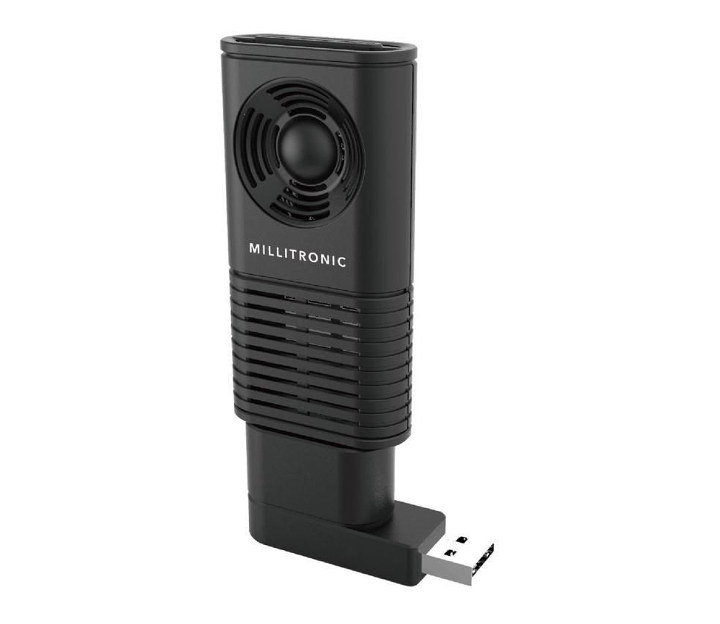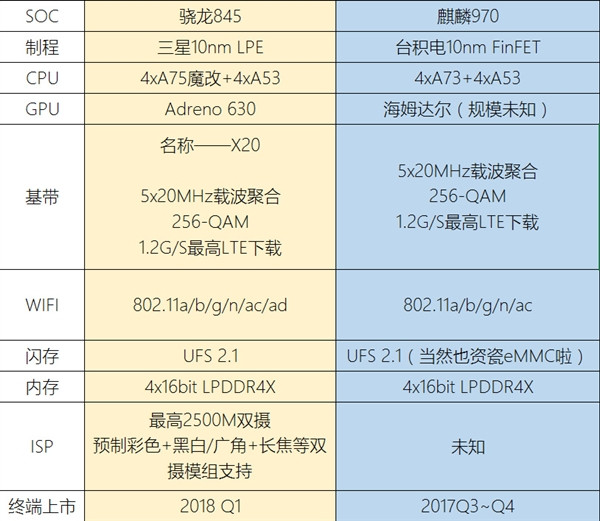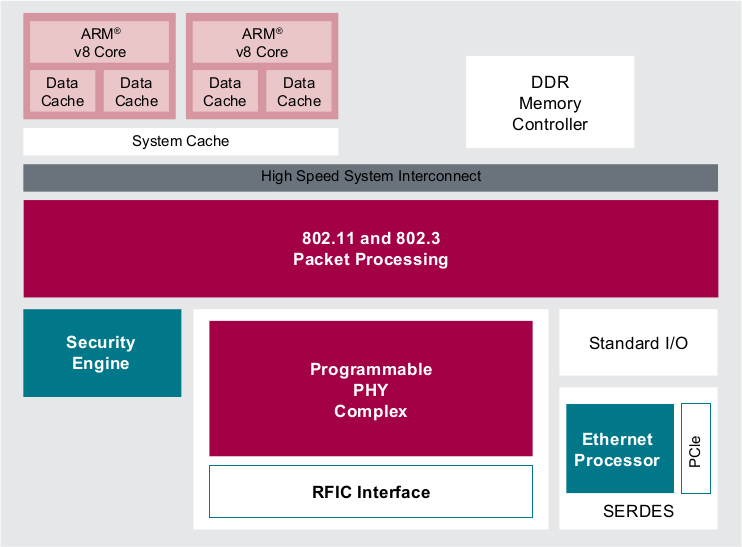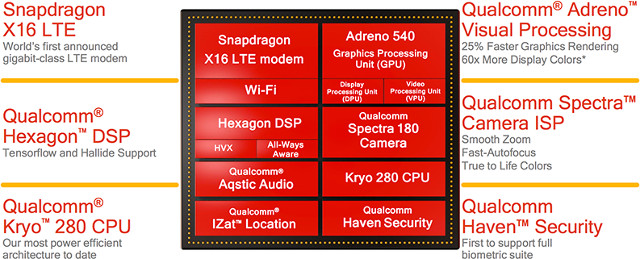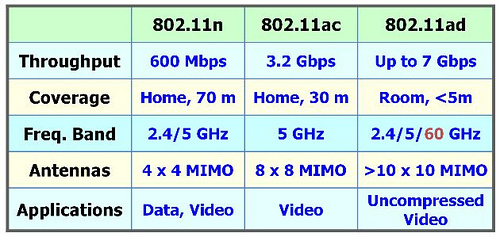802.11ad was announced in 2016 as a new WiFi standard supporting 60 GHz frequency and up to 7 Gbps throughput, but it has recently been superseded by the backward compatible but further improved 802.11ay allowing up to 100 Gbps bandwidth, and 300 to 500 meters range in theory. The new standard is supported by Qualcomm QCA64x8 and QCA64x1 WiFi chipsets that can handle up to 10 Gbps, and found in Snapdragon 855 mobile processor. If you want your network to benefit from 802.11ad WiFi – 802.11ay is not quite available yet – , you’ll first new a compatible router such as NETGEAR Nighthawk X10 AD7200 router, and end nodes supporting 802.11ad WiFi as well as. But most device on the market don’t, and in theory you should be able to add 802.11ad WiFi to any device with a USB 3.0 port, but it turns out there aren’t that many 802.11ad […]
Qualcomm Snapdragon 845 Octa Core Kryo 385 SoC to Power Premium Smartphones, XR Headsets, Windows Laptops
Qualcomm Snapdragon 845 processor was expected since May 2017 with four custom Cortex A75 cores, four Cortex A53 cores, Adreno 630 GPU, and X20 LTE modem. with the launch planned for Q1 2018. At least, that what the leaks said. Qualcomm has now formally launched Snapdragon 845 Mobile Platform and rumors were mostly right, as the the octa-core processor comes with four Kryo 385 Gold cores (custom Cortex A75), four Kryo 385 Silver cores (custom Cortex A55) leveraging DynamIQ technology, an Adreno 630 “Visual Processing System”, and Snapdragon X20 modem supporting LTE Cat18/13. The processor is said to use more advanced artificial intelligence (AI) allowing what the company calls “extended reality (XR)” applications, and will soon be found in flagship smartphones, XR headsets, mobile PCs, and more. Qualcomm Snapdragon 845 (SDM845) specifications: Processor 4x Kryo 385 Gold performance cores @ up to 2.80 GHz (custom ARM Cortex A75 cores) 4x […]
Intrinsyc Open-Q 835 Development Kit Features Qualcomm Snapdragon 835 Processor, Support Android 7 and Windows 10
Intrinsyc has just launched one of the first development boards powered by Qualcomm Snapdragon 835 processor with their Open-Q 835 devkit equipped with 4GB LPDDR4x, 128GB UFS 2.1 flash, 802.11ad WiFi, dual camera support and more. Open-Q 835 development kit is comprised of a “processor board” and a baseboard with the following specifications: Processor Board SoC – Qualcomm Snapdragon 835 (APQ8098) octa-core processor with four high performance Kryo 280 cores @ 2.20 GHz/ 2.30 GHz (single core operation), four low power Kryo cores @ 1.9 GHz, Adreno 540 GPUwith OpenGL ES 3.2, OpenCL 2.0 Full support, and Hexagon 682 DSP with Hexagon Vector eXtensions (dual-HVX512) System Memory – 4GB LPDDR4x RAM Storage – 128GB UFS2.1 Gear3 2 lane Flash Connectivity Wi-Fi 802.11a/b/g/n/ac 2.4/5Ghz 2×2 Bluetooth 5.0 + BLE WiGig60 802.11ad with on-board antenna Dimensions – 70 x 60 mm Carrier Board Display – 1x HDMI 2.0 out up to 4K Ultra […]
Qualcomm Unveils Mesh Networking WiFi Router / Gateway Reference Design Powered by IPQ40x8/9 NSoC
Qualcomm has just announced the Qualcomm Mesh Networking Platform for OEM and broadband providers to design home WiFi routers/gateways capable of providing “robust and consistent connectivity”, and feature voice control capabilities, centralized management and security, and a range of mesh system features. In order to speed up adoption the the platform, the company introduced the Qualcomm Mesh Networking Reference Design with the following key features & benefits: Network System-on-Chip (NSoC) – Qualcomm IPQ40x8/9 network system-on-chip with four Cortex A7 cores, 802.11ac WiFi 2×2+2×2, network and crypto accelerators Qualcomm Wi-Fi Self-Organizing (SON) feature suite will ensure corner-to-corner Wi-Fi coverage, easy set-up, automatic management and traffic optimization, as well as additional security safeguards. Carrier-Grade features with Wi-Fi SON APIs, cloud-based diagnostics Integrated voice capabilities thanks to built-in microphone array and speaker, voice recognition software, and APIs support for popular cloud-based assistant applications. Variety of backhaul options to be used to maximize the […]
Qualcomm Snapdragon 845 Octa-core Processor To Feature ARM Cortex A75 Cores (Reports)
According to reports from China, Qualcomm’s next application processor (or rather mobile platform) will be Snapdragon 845, and if accurate, the comparison table below between the Snapdragon processor and Hisilicon Kirin 970 SoC shows the former will be powered by some customized (魔改) version of yet-to-be announced ARM Cortex 75 cores. Snapdragon 845 octa-core processor will be manufactured using Samsung 10nm LPE processor, come with four custom Cortex A75 cores, four Cortex A53 cores, an Adreno 630 GPU, and an LTE X20 modem supporting LTE Cat 18 for up to 1.2 Gbps download speed. Other features like 802.11ad (High bandwidth, short range WiFi), UFS 2.1, and LPDDR4X were already found on earlier model. I’ve been unable to find further details about ARM Cortex A75 right now, and we have to wait until ARM Techcon 2017 before getting more details. Mobile phones powered by Snapdragon 845 are supposed to start shipping […]
NXP QorIQ LayerScape LA1575 Programmable Wireless SoC to Support 5G, 802.11ax & 802.11ad WiFi, and Wireline
NXP has recently announced QorIQ LayerScape LA1575 programmable wireless platform with two ARMv8 cores, and simultaneous multi-standard support for 5G, Wi-Fi (802.11 ac and 802.11ax) and Wireline systems for enterprise and high-end home gateways. QorIQ LayerScape LA1575 key features and specifications: Multicore ARMv8 Processors for user applications DDR4 with ECC Programmable accelerator engines for signal processing. Programmable low latency MAC layer processing engines Programmable high performance packet processing engines to over 10 Gbps Configurable cryptographic offload engines Simultaneous multi-standard support for 5G, Wi-Fi (802.11 ac and 802.11ax) and Wireline systems Multiple Ethernet interfaces including 10Gbps PCIe gen 3.0 Integrated Trust architecture Single source clocking The main benefit of this SoC is that is is programmable, so even if some standards evolve after the release, it can be re-programmed to reflects the changes in specifications. Just to refresh everybody’s memory: 5G is the successor of 4G/LTE scheduled to start (Wave 1) around 2018, […]
Qualcomm Officially Unveils Snapdragon 835 Octa-core Processor for Smartphones, Mobile PCs, Virtual Reality…
Qualcomm first mentioned Snapdragon 835 processor in November, but at the time, they only disclosed it would be manufactured using 10nm process technology in partnership with Samsung, and claimed the obvious “faster and lower power consumption” compared the previous generation. The company has now provided much more info ahead of CES 2017. Snapdragon 835 key features and specifications: Processor – 8x Kryo 280 cores used into two clusters: performance cluster with 4x cores @ up to 2.45 GHz with 2MB L2 cache efficient cluster with 4x cores @ up to 1.9 GHz with 1MB L2 cache GPU – Adreno 540 GPU with support for OpenGL ES 3.2, OpenCL 2.0 full, Vulkan, DX12 DSP – Hexagon 682 DSP with Hexagon Vector eXtensions and Qualcomm All-Ways Aware technology Memory I/F – dual channel LPDDR4x Storage I/F – UFS2.1 Gear3 2L, SD 3.0 (UHS-I) Display – UltraHD Premium-ready , 4K Ultra HD 60 […]
The First Devices and Routers with WiFi 802.11ad Delivering Up 7Gbit/s Transfer Rates at 60 GHz Will Be Available This Year
802.11ad is the latest and fastest WiFi standard working in the 60 GHz band and delivering up to 7 Gbit per second data transmission rates. The 60 GHz frequency band offers both advantages and disadvantages because it does not penetrate through walls nor water, meaning it can only be used within a room limiting the range, but at the same time it’s more secure since it cannot be snooped from the outside, and for people who worry about health effects it does not penetrate the human body. 802.11ad routers will also be able to switch to 2.4 and 5.0 GHz frequency bands in order to go through walls. The table above nicely summarize the key features of 802.11ad over 802.11ac and 802.11n, however the throughput row shows the theoretical maximum throughput, but in practice, using 802.11ac as example, clients are often limited to 433 or 866 Mbps, and distance and […]


